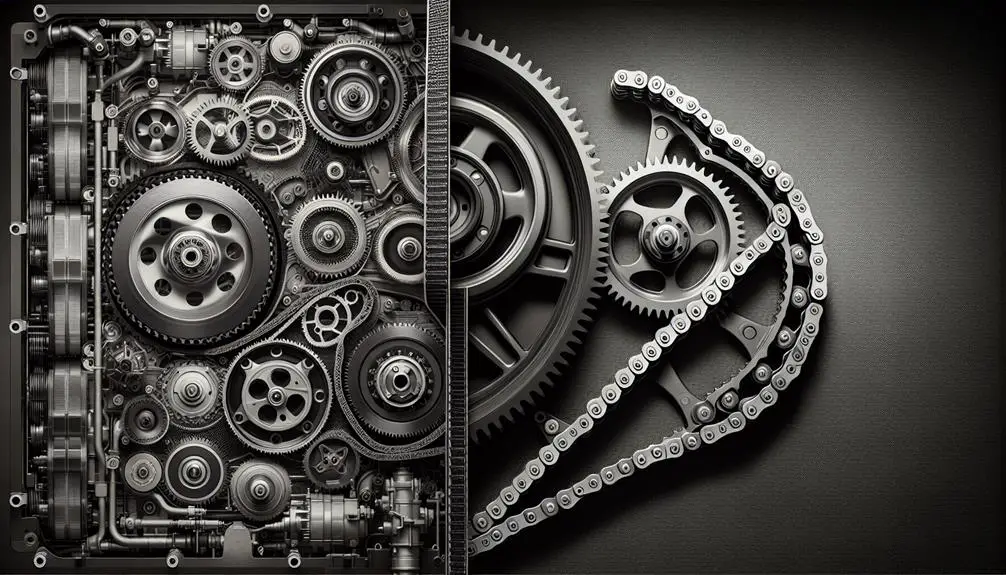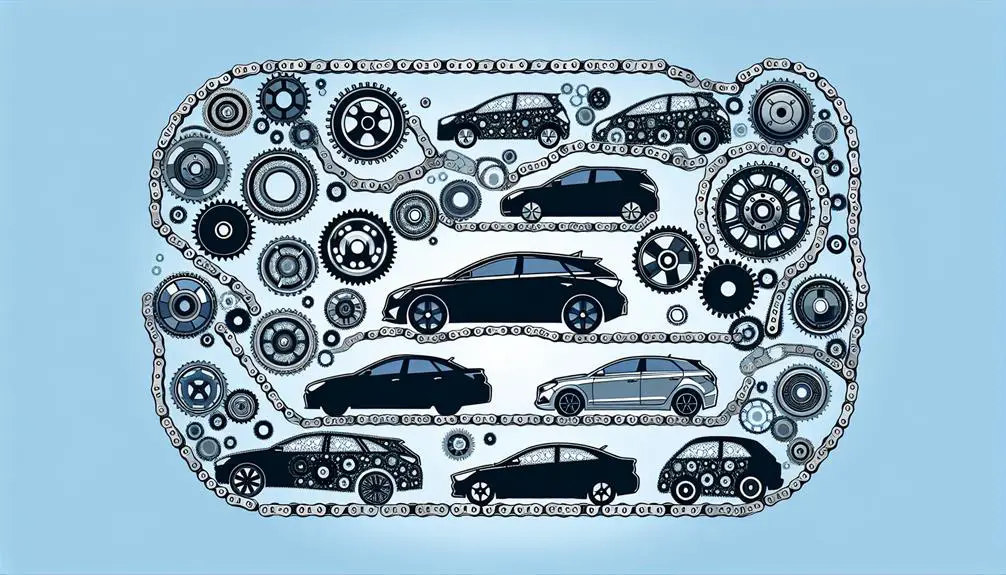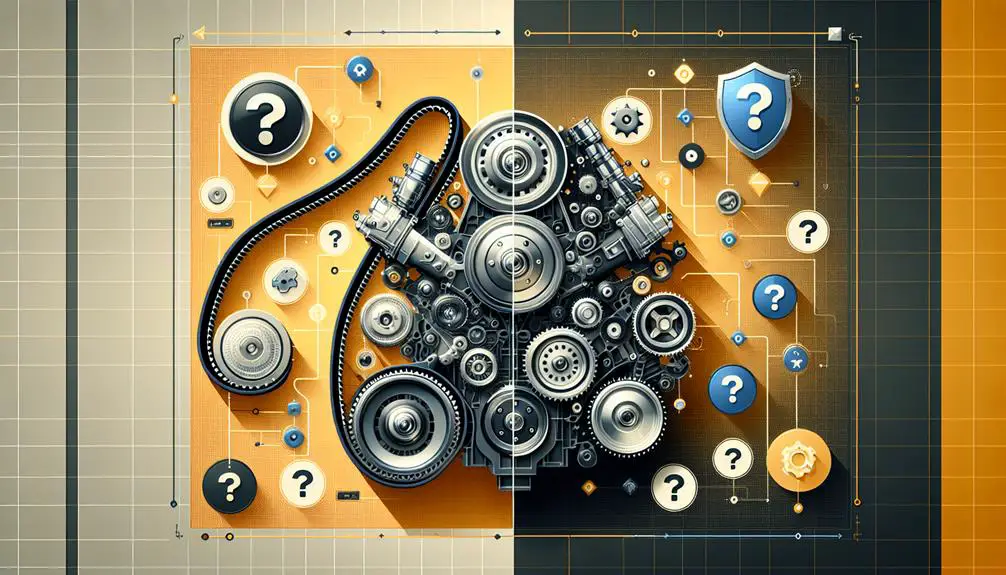Hyundai vehicles come with either timing belts or chains, depending on the model.
As you navigate Hyundai's engine mechanisms, it's crucial to know which your model has. This knowledge could impact your maintenance schedule and help avoid unexpected repair costs.
We'll explore which Hyundai models have timing belts and which have chains, along with essential maintenance tips to ensure your vehicle performs optimally.
Understanding the difference is key to maintaining your Hyundai's performance.
Understanding Timing Mechanisms

To comprehend your Hyundai's performance, it's vital to grasp how timing belts or chains, the heartbeats of the engine, harmonize its moving parts. Delving into timing mechanism history, it's fascinating to observe the evolution from belts to chains. Initially, rubber-based belts were favored for their quiet operation and cost-effectiveness. However, chains, made of metal, offer durability and longevity, notwithstanding being noisier and more expensive.
The performance impact of these components can't be overstated. Timing belts and chains make sure that the engine's valves open and close at precisely the right moments, allowing for maximum combustion. This synchronization is pivotal for maintaining engine efficiency, power output, and fuel economy. A failure in this system can lead to catastrophic engine damage, emphasizing the significance of regular maintenance.
Choosing between a timing belt and a chain ultimately depends on a balance between immediate costs and long-term value. While belts may require more frequent replacement, the initial investment is lower. Conversely, chains, with their sturdy construction, promise extended service life at a higher upfront cost. Comprehending these dynamics is key to maximizing your Hyundai's performance and longevity.
Hyundai Models With Timing Belts
Knowing the timing mechanisms in your Hyundai highlights the importance of knowing if your model uses a timing belt. Timing belts, made of rubber and high-tensile fibers, are critical for synchronizing your engine's camshaft and crankshaft rotations. Understanding your Hyundai's timing belt is essential for maintaining engine health and preventing costly repairs.
Belt longevity varies by model and driving conditions, but typically, Hyundai recommends a timing belt replacement every 60,000 to 100,000 miles. Recognizing replacement indicators is vital for avoiding engine damage. Signs include a ticking noise from the engine, the engine not starting, or a misfire during operation. These symptoms might indicate your timing belt is worn out or has snapped.
Regular inspections can help identify wear and tear before it leads to severe issues. A visual check might reveal cracks, splits, or excessive slack, signaling it's time for a replacement. Given the belt's pivotal role in your engine's function, ensuring its integrity is vital.
Hyundai Models With Timing Chains

Switching lanes, let's investigate Hyundai models equipped with timing chains, a durable alternative to belts, designed for the lifetime of the engine under normal conditions. Unlike timing belts, chains are sturdy and generally require less maintenance, making them a preferred choice for many. They're built to withstand the engine's demands without the need for periodic replacement, as is the case with belts.
When considering chain durability comparisons, it's crucial to note that timing chains are engineered to match the lifespan of the engine. However, the actual longevity can be influenced by factors such as oil quality and maintenance habits.
For those looking to improve their vehicle's performance or perhaps prolong the life of the timing chain further, aftermarket chain options are available. These alternatives often boast improved durability or are tailored for specific performance needs.
To give you a clearer picture, here's a quick look at some Hyundai models featuring timing chains:
| Model | Engine Type |
|---|---|
| Hyundai Sonata | Turbocharged |
| Hyundai Santa Fe | V6 |
| Hyundai Veloster | Turbocharged |
| Hyundai Genesis | V6 & V8 |
This overview underscores the blend of reliability and performance offered by Hyundai's chain-driven engines.
Maintenance Tips and Schedules
Regular maintenance is essential for ensuring your Hyundai's engine runs smoothly and efficiently. Ignoring routine service can lead to costly repairs and decreased performance over time. One of the most critical aspects of maintenance is understanding the oil changes importance. Your engine's oil lubricates moving parts, minimizes friction, and helps dissipate heat. Over time, oil breaks down and becomes less effective, making regular oil changes crucial for preventing engine wear and overheating.
Equally important is recognizing the coolant flush necessity. The cooling system in your Hyundai prevents the engine from overheating by circulating coolant. However, coolant can become contaminated and less effective at heat dissipation. A coolant flush involves draining the old coolant, cleaning the system, and refilling it with fresh coolant. This process helps prevent corrosion, overheating, and engine damage.
Adhering to Hyundai's recommended maintenance schedule ensures that your vehicle receives these critical services at the appropriate intervals. Typically, oil changes should occur every 5,000 to 7,500 miles, depending on your driving habits, while coolant flushes are advised every 30,000 miles or as specified in your owner's manual. Staying on top of these tasks will help keep your Hyundai running efficiently and reliably for years to come.
Common Questions Answered

After covering the importance of maintenance for your Hyundai, you might've several questions about the specifics of timing belts or chains. Understanding these components is vital for ensuring the longevity and reliability of your vehicle. Here's a breakdown of the most common inquiries:
- What's the typical belt lifespan?
Timing belts have a lifespan that generally ranges between 60,000 to 100,000 miles. However, this can vary based on your driving habits and the specific model of your Hyundai. It's important to consult your vehicle's manual or a professional mechanic for the exact replacement intervals.
- How can I identify chain noise?
A timing chain might start to produce a rattling noise if it becomes loose or worn. This sound is usually most noticeable during startup and tends to diminish once the engine reaches its operating temperature. If you hear this noise, it's a sign that your timing chain may require inspection or replacement.
- Is there a difference in maintenance for belts vs. chains?
Yes, timing belts typically require replacement at specific intervals, as failure can lead to severe engine damage. Timing chains, on the other hand, are designed to last the life of the engine but may need attention if symptoms like chain noise occur. Regular inspections are key to identifying issues early.
Conclusion
To sum up, whether your Hyundai has a timing belt or chain greatly impacts maintenance needs. Models equipped with belts require more frequent checks and potential replacements, while those with chains generally offer longer-lasting durability.
Adhering to Hyundai's maintenance schedule guarantees peak performance. Remember, regular inspections are key to preventing costly repairs.
If you're unsure about your vehicle's specific needs, consulting the owner's manual or a professional mechanic can provide clarity and peace of mind.